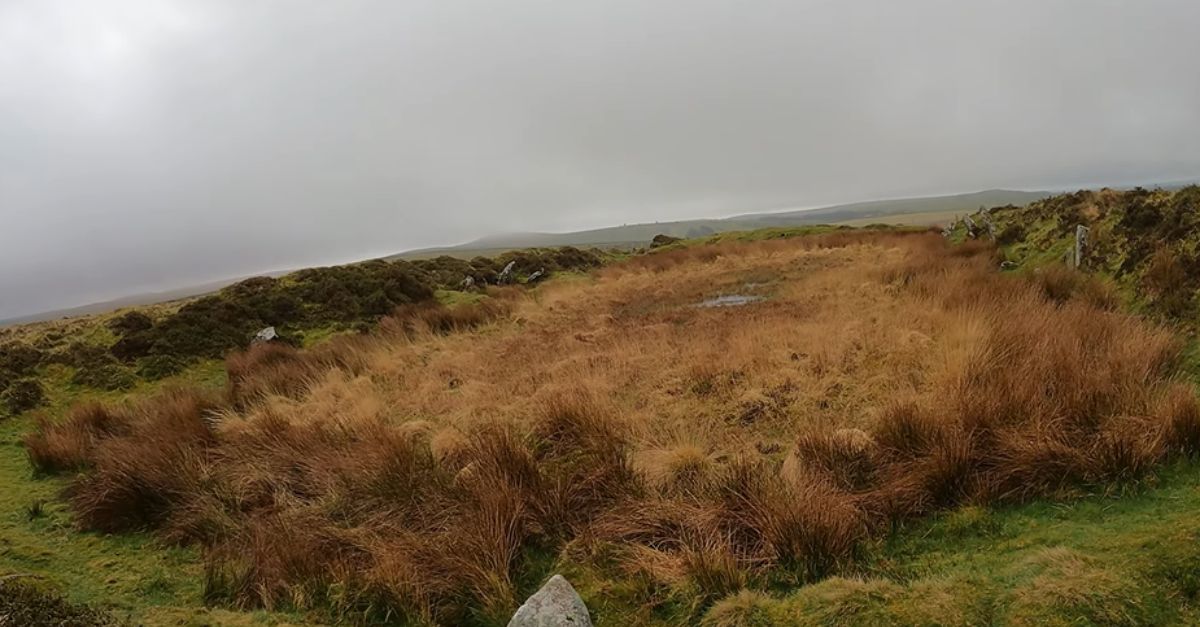The Ancient Cornish Monument
A row of stones held secrets for millennia. Known as King Arthur’s Hall, it was long thought to be medieval. But what if that timeline was off by thousands of years?

The Stone Enclosure That Refused To Be Forgotten
Hidden in the windswept stretch of Bodmin Moor, a strange rectangular formation once dismissed as a collapsed animal pen has quietly endured for millennia. Known today as King Arthur’s Hall, this stone-lined site raised more questions than answers until recently.
 Sandy Gerrard , Wikimedia Commons
Sandy Gerrard , Wikimedia Commons
As Cornish Fog Keeps Ancient Secrets Close
Bodmin Moor, located in northeast Cornwall, is home to one of the highest concentrations of prehistoric monuments in southwest England. Its remote and rugged nature has helped preserve several sites. While their original purposes remain uncertain, these stone structures have long been recognized by local communities as historically significant.
 Theroadislong, Wikimedia Commons
Theroadislong, Wikimedia Commons
How A Name Like “King Arthur’s Hall” Fuels Centuries Of Speculation
The name alone invites imagination. “King Arthur’s Hall” sounds like it was pulled from a medieval saga, and that’s part of the charm. No one knows who first attached the legendary king’s name to this site, but it stuck, shaping public perception for generations. The truth? Arthur never set foot here.
 Charles Ernest Butler, Wikimedia Commons
Charles Ernest Butler, Wikimedia Commons
The Place That Makes You Believe In Legends
You don’t have to believe in magic to feel something stir out on the moor. Untouched and eerily quiet, the setting does half the storytelling for you. There’s a reason so many myths cling to places like this, as the location lets your mind wander thinking about what happened here.
 Sheila Russell, Wikimedia Commons
Sheila Russell, Wikimedia Commons
Ancient Sites Borrow The Names Of Heroes
Across the British Isles, ruins wear borrowed names from legendary characters: Arthur, Merlin, even giants and druids. It’s human nature to fill silence with story. Without written records, early people turned to legend to explain the inexplicable.
 King Arthurs Hall by Turbo Tim's World
King Arthurs Hall by Turbo Tim's World
A Theory That Missed The Mark
For a long time, the best guess was that King Arthur’s Hall was medieval, maybe a sheep enclosure or cattle pound. That theory stuck because it was practical. It turns out that those stones weren’t built by farmers but by people who lived thousands of years before humans practiced farming.
 King Arthur's Hall Excavation by Cornwall National Landscape
King Arthur's Hall Excavation by Cornwall National Landscape
Maps Guessed More Than They Knew
Some primitive maps marked the site vaguely, if at all, often surrounded by speculative scribbles or vague titles. Explorers and antiquarians cataloged it with half-formed theories and artistic liberties. These early documents were attempts to frame the mysterious in familiar terms.
 King Arthurs Hall by Turbo Tim's World
King Arthurs Hall by Turbo Tim's World
Why Historians Once Thought It Was Just A Pen
Early historians didn’t have satellite imagery and all they could do was guess. When they saw a rectangular earthwork in a field, they labeled it a livestock enclosure. It made sense on paper but that explanation collapsed once dating methods revealed just how ancient this place really was.
 King Arthurs Hall by Turbo Tim's World
King Arthurs Hall by Turbo Tim's World
Several Generations Got The Story Completely Wrong
For centuries, King Arthur’s Hall lived under an identity crisis. Locals called it Arthur’s, scholars called it medieval, and neither was right. Generations passed down flawed assumptions, unintentionally steering research in the wrong direction. Even when stories feel old enough to trust, they can still miss the truth by miles.
 King Arthurs Hall by Turbo Tim's World
King Arthurs Hall by Turbo Tim's World
A Science Team Looked Beyond The Legend
It took a new generation of archaeologists, who were less charmed by folklore and more driven by data, to challenge old theories. Armed with advanced dating tools and fresh curiosity, they studied everything beneath their feet. And what they found pulled the whole timeline backward by millennia.
 King Arthur's Hall Excavation by Cornwall National Landscape
King Arthur's Hall Excavation by Cornwall National Landscape
Neolithic Clues Hid Right Under Everyone’s Noses
Sometimes, the truth isn’t buried deep; it’s just overlooked. Traces of ancient activity, from pollen fragments to insect shells, were trapped in the ground around the stones. These overlooked clues told a story far older than the medieval narrative.
 King Arthur's Hall Excavation by Cornwall National Landscape
King Arthur's Hall Excavation by Cornwall National Landscape
Dirt And Darkness Helped Reveal The Truth
To date something that far back, researchers used a technique called Optically Stimulated Luminescence. It reads the last time sediment saw daylight. In short, they studied how long the dirt had been undisturbed. This process confirmed the site had stood there since the Neolithic.
 King Arthur's Hall Excavation by Cornwall National Landscape
King Arthur's Hall Excavation by Cornwall National Landscape
Everything We Knew Fell Apart
When the test results came in, timelines snapped. The site was no longer medieval—it was prehistoric. Built over 5,000 years ago, the monument’s age shocked even the experts. It meant the people who built this weren’t farmers from the Middle Ages. They were among Britain’s earliest monument-makers.
 King Arthurs Hall by Turbo Tim's World
King Arthurs Hall by Turbo Tim's World
What This Age Means For British History
The Hall’s new timeline forced historians to redraw maps of ancient Britain, at least mentally. Suddenly, Bodmin Moor became a hub of early human culture. It could be a place of ritual or gathering long before even Stonehenge rose from the plains.
 King Arthurs Hall by Turbo Tim's World
King Arthurs Hall by Turbo Tim's World
A Monument That Looks Nothing Like Its Peers
Most ancient monuments follow familiar shapes like circles or rows of stones. But King Arthur’s Hall breaks the mold. Its long rectangular layout, framed by standing stones and sunken in the earth, doesn’t match most designs from its era. It stands almost alone in the archaeological record.
 King Arthurs Hall by Turbo Tim's World
King Arthurs Hall by Turbo Tim's World
The Mystery Behind Those 56 Standing Stones
Each of the Hall’s 56 stones lines the inner edge of the embankment, their placement too deliberate to be random. They weren’t for fencing livestock or supporting a roof. These stones meant something. Maybe they represented people or celestial events. Nobody knows for sure.
 King Arthurs Hall by Turbo Tim's World
King Arthurs Hall by Turbo Tim's World
Why The Rectangle Shape Still Baffles Experts
In Neolithic Britain, circles were sacred. So why build a perfect rectangle? Some believe it mimicked early timber structures, now long gone. Others think it channeled specific views of the sky. One thing’s certain: its rectangular shape was rare then, and it’s rare now.
The Sunken Floor That Defies Explanation
When you step inside the enclosure, you’ll find the ground drops slightly below the surrounding area. This sunken design has sparked endless speculation. Was it ceremonial, defensive, or symbolic? No consensus exists, but the depth adds dimension to the monument’s mystery.
This Is Why No One’s Found Anything Quite Like It
King Arthur’s Hall is the only known Neolithic monument in Britain, which has a rectangular layout enclosed by standing stones. Most prehistoric structures from this era are circular or linear in form. Its distinctive shape, combined with its age, sets it apart from thousands of other sites across Europe.
 Chris Andrews , Wikimedia Commons
Chris Andrews , Wikimedia Commons
Such Layout Suggests Deliberate Ritual Or Gathering Use
The rectangular design of King Arthur’s Hall, enclosed by evenly spaced standing stones and sunken below ground level, suggests it was not intended for shelter or storage. The structure lacks evidence of domestic use. Its formal layout indicates a space likely built for communal gatherings or ritual activity.
 King Arthurs Hall by Turbo Tim's World
King Arthurs Hall by Turbo Tim's World
A Ceremonial Center Hidden In Plain Sight
The absence of artifacts doesn’t mean nothing happened here. It might mean what happened wasn’t material. Ancient communities often gathered in open enclosures for rituals tied to seasons or ancestors. King Arthur’s Hall may have been less about possessions and more about presence.
 King Arthurs Hall by Turbo Tim's World
King Arthurs Hall by Turbo Tim's World
Theories Range From Sky Worship To Social Order
Some researchers speculate the Hall was aligned with celestial events, perhaps a Neolithic calendar. Others suggest it reflected tribal structure, where placement within the enclosure mirrored social rank. These guesses are grounded in how similar cultures built meaning into space.
 Philip Halling , Wikimedia Commons
Philip Halling , Wikimedia Commons
It Could Have United Tribes
Its sheer size suggests it wasn’t meant for one family or clan. Instead, King Arthur’s Hall may have been neutral ground—a rarely shared site for neighboring groups. It could have been used for seasonal meetings or alliance rituals that bring several tribes together.
 What is King Arthur's Hall? by Cornwall National Landscape
What is King Arthur's Hall? by Cornwall National Landscape
The Power Of Rituals Etched Into Earth And Stone
Before temples and texts, people marked meaning with land and rock. The Hall’s deliberate shape and stone count suggest rituals, though their details are lost. Maybe it was for birth, death, harvest, or time itself. Whatever the case, it was a place where something significant happened.
Silence Speaks Louder Than Any Relic
Most historic sites offer clues with pottery shards, bones, tools, or weapons. But here, absence is the message. The lack of debris points to intentionality: people didn’t live or labor here. They gathered, then left. That ritualized use may tell us more about ancient beliefs than any broken artifact.
What Ancient Architecture Tells Us About Human Nature
Even without language or blueprints, humans have always shaped the world to reflect meaning. King Arthur’s Hall is a physical thought: a manifestation of ritual or identity. Its very existence shows the drive to build and gather.
 Greens and Blues, Shutterstock
Greens and Blues, Shutterstock
The Geometry Suggests Tells Us Ancient Thought
Rectangles imply planning. The Hall was designed in that particular shape for a reason. It suggests abstract thinking, an ability to conceptualize space and form. The proportions may reflect early mathematics or symbolic frameworks we no longer understand.
The Sacred Geography Of Bodmin Moor Comes Into Focus
Once seen as just a bleak moorland, Bodmin now reveals itself as a sacred location. Nearby stone circles and burial mounds suggest a wider ceremonial network. King Arthur’s Hall was part of a prehistoric conversation carved by people with something to say.
 Hugh Venables, Wikimedia Commons
Hugh Venables, Wikimedia Commons
Nearby Monuments Add Context To The Mystery
Bodmin Moor holds more than just one enigma. Just beyond the Hall lie stone rows and natural tors once shaped for spiritual use. These monuments don’t repeat the Hall’s layout but echo its purpose with spaces carved out for gathering and reverence.
 Mick Knapton, Wikimedia Commons
Mick Knapton, Wikimedia Commons
Clues Hidden In The Shadows Of Rough Tor
Rough Tor looms in the distance, its craggy silhouette is impossible to ignore. This natural landmark likely played a role in how early people placed their structures. King Arthur’s Hall might’ve been aligned to face or mirror it.
Cornwall May Have Been A Cultural Crossroads
Cornwall’s coastline opened it to trade and ideas, even in prehistory. Its central uplands, like Bodmin Moor, could have acted as spiritual centers inland. The Hall’s unusual design may reflect influences not found elsewhere in Britain.
 Tom Chambers, Wikimedia Commons
Tom Chambers, Wikimedia Commons
A Quiet Field That Reshaped Britain’s Prehistoric Timeline
King Arthur’s Hall provided concrete evidence that complex architectural sites existed in southern Britain over 5,000 years ago. Its Neolithic origin challenges previous assumptions that such symbolic structures were limited to areas like Wessex. The discovery caused a reassessment of the region’s role in prehistoric cultural and ceremonial development.
Ancient Ceremony Shaped The British Terrain
Long before cathedrals or castles dotted the map, sacred spaces were carved into moors, mounds, valleys, and hills. King Arthur’s Hall belongs to a wider tradition, where Neolithic people shaped the land to reflect their beliefs. These spaces altered how people experienced the terrain and how the terrain shaped identity.
 King Arthurs Hall by Turbo Tim's World
King Arthurs Hall by Turbo Tim's World
But Time And Tourism Threatened Its Survival
Like many ancient sites, King Arthur’s Hall faced modern pressures. Curious visitors, livestock, conflicts, and weather all took a toll. Stones were loosened, and the original design began to erode. Without protection, the monument might have vanished.
 Current theories about the origin of King Arthur's Hall by Cornwall National Landscape
Current theories about the origin of King Arthur's Hall by Cornwall National Landscape
Conservation Work Quietly Saved The Site
Realizing the Hall’s value, preservationists acted. A gated fence now limits access and careful management is prioritized. This might not sound flashy, but this site needs steady protection. These efforts rescued a chapter of history from slipping into the soil for good.
 King Arthurs Hall by Turbo Tim's World
King Arthurs Hall by Turbo Tim's World
But Preserving The Past Takes More Than Fencing It Off
Protecting King Arthur’s Hall goes beyond putting up a barrier. It means educating visitors and funding research. True conservation is cultural as it keeps stories alive, not just stones standing. And in places like this, preservation becomes a dialogue between present care and ancient purpose.
 King Arthurs Hall by Turbo Tim's World
King Arthurs Hall by Turbo Tim's World
A Single Site Forces Us To Rethink The Past
Every once in a while, a discovery nudges the whole timeline. King Arthur’s Hall did just that. What was once a footnote in Cornish folklore became a headline in Neolithic studies. It reminded historians that big revelations could be hiding in plain sight for 5,000 years.
 Richard Bartz, Wikimedia Commons
Richard Bartz, Wikimedia Commons
Curiosity Remains Our Greatest Tool
Archaeology thrives on questions more than answers. What changed King Arthur’s Hall was asking again and looking closer, not accepting “probably medieval” as the final word. Curiosity peeled back centuries of assumption and exposed something timeless.
 Current theories about the origin of King Arthur's Hall by Cornwall National Landscape
Current theories about the origin of King Arthur's Hall by Cornwall National Landscape
For A Monument That Defied Easy Labels
This site doesn’t check the boxes: not a tomb, fortress, pen, or home. That’s what makes King Arthur’s Hall extraordinary. It resists classification and forces scholars and visitors to sit with uncertainty. Other nearby sites could also shed light on eras we didn’t know much about.
 King Arthurs Hall by Turbo Tim's World
King Arthurs Hall by Turbo Tim's World
Other Artifacts Were Found
Apart from the Hall, archaeologists also found a hoard of objects near Melsonby in North Yorkshire. Research showed that some of the findings date back to the first century AD, about the time of the Roman conquest. Among the artifacts are the remains of seven wagons and two chariots.
 Rebecca Griffiths, Wikimedia Commons
Rebecca Griffiths, Wikimedia Commons
That Tell A Lot About The People Who Lived There
The discovery included other items like ceremonial spears, linchpins, rings, and other pieces of jewelry. Moreover, they found vessels that were likely used to mix wine. Researchers believe that the items probably belonged to an elite class.
 Help Us Save The Melsonby Hoard by YorkMuseumsTrust
Help Us Save The Melsonby Hoard by YorkMuseumsTrust
And Raise Awareness
New Discoveries draw attention to sites that weren’t under the spotlight for centuries. Archaeologists believe that these new findings will help raise funds and awareness once made accessible to the public who’d like to know more about Britain’s ancient history.
 Help Us Save The Melsonby Hoard by YorkMuseumsTrust
Help Us Save The Melsonby Hoard by YorkMuseumsTrust
Bodmin Moor Became A Living Archive
Bodmin Moor is a museum with no walls. King Arthur’s Hall is one artifact among many, but it anchors a much older story stitched into the hills. When you walk here, you step into what shaped the history of Britain in different eras.
 Raimond Spekking, Wikimedia Commons
Raimond Spekking, Wikimedia Commons
This Ancient Enclosure Still Matters Today
In an age of speed and instant answers, King Arthur’s Hall stands as a reminder of slower truths. It asks us to look harder and respect what we don’t fully understand. That might be its real legacy but archaeologists are also working hard, hoping it could provide more answers.
 King Arthurs Hall by Turbo Tim's World
King Arthurs Hall by Turbo Tim's World














